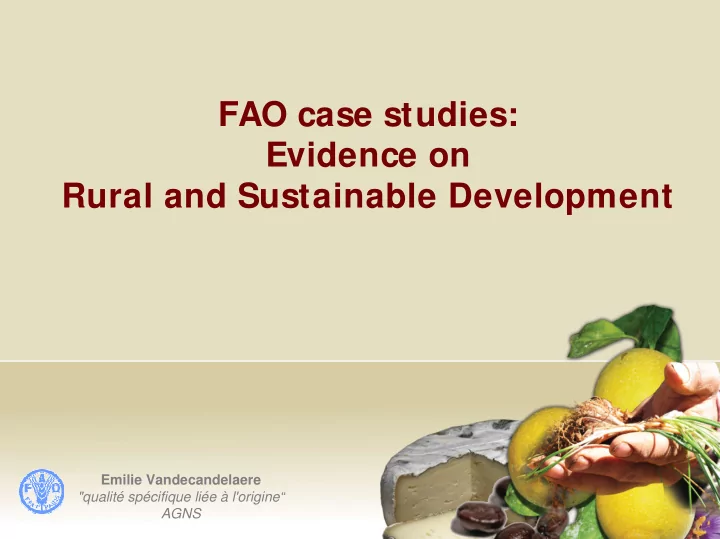

FAO case studies: Evidence on Rural and Sustainable Development Emilie Vandecandelaere "qualité spécifique liée à l'origine“ AGNS
Outline 1. Some evidence regarding sustainable development: Objectives of promoters • Other activities (tourism) • Contribution to biodiversity • Social aspects • 2. Towards recommendations...
Some evidence
Objectives of promoters Other than economic (see first presentation) • Preservation of biodiversity and environement (Chuao, Arriba, Neuquen, Livno, safran...) • Traditions, know how and cultural assets preservation, in marginalised areas (Cotija, Turrialba, Neuquen, safran...) • To improve living conditions and maintain rural population (Lemon, Neuquen, Cotija, Arriba, safran) • To implement pilot cases (Turrialba-Costa Rica, Giant Maiz- Peru)
Links with other activities • Tourism is based also on the valorisation of local resources (natural, cultural), importance of the identity � synergy between promotion of the quality product linked to geographical origin and tourism • Traditional tourism that contributes to the reputation (Ma í z del Cusco/Valle de Urubamba) • Development of touristic activities and job creation (Caf é de Colombia: Parque Caf é , Feria del Caf é , Agritourism; Safran – agritourism) • Tourist markets: product fairs and direct selling (Cotija, Turrialba, Livno cheese, Uzice ham, safran … .) � reinforce or create rural activities, diversification, employment
Biodiversity • Preserve and promote specific varieties (Cacao, white maize, Tetovo?...) and local races (Neuquen) adapted to their environment • Preservation or recuperation of landscapes, pastures and their biodiversity (Neuquen, Livno,...) • Raise awareness of producers on the environmental challenges (Maize, Pica, Safran, Livno...) � Environment and biodiversity preservation are not a primary objective but an important consequence thanks to the specifications: guidance for this? � Analyze of the impact case by case (e.g. increase of production can be positive or not) � Importance in area with ecologic interest (Unesco biosphere in Souss Madra, Livno Polje...) : importance of creating synergy between projects (economic, preservation)
“quality is a social construction”... • Increase of producers self esteem through the focus and valorization of local resources, culture and practices race and way of living (fairs, Prizes, recognition) and “territorial esteem” (Neuquen: “school talent show” to find the logo...) • Preservation of “way of living” (Cotija, Turrialba, Neuquen “criancero”) • Contribute to maintain rural population (objective of producers, Neuquen) • Creation of social/professional networks and strengthening of the local associations/cooperatives • Role of women (cacao chuao, Livno cheese, Safran) BUT: • Problems of frustration and demotivation when delays... • No exclusion observed (yet?) but possible gap between leaders and followers...(Cotija)
Towards recommendations
Key points � Link to territory is the potential for rural development – Valorization of traditional products: a way to preserve non- standardized food products and the socio-ecological system associated, to maintain population and activities in rural areas – Marginalized areas: constraints turned out as assets – Ecologic value areas: a contribution from the production side to manage sustainable development – Tourism: a complementary activity based on identity (to be controlled...) • But... not for all products and everyone: reputation (market), markets where to promote the specificities, capacity to move forward... • And: modalities of elaboration and content of the Code of practice (specifications)
Draft recommendations • Again concerning the code of practice (specifications) : – Social aspects: elaboration (participative definition – vertical/horizontal links), involving all the territorial actors in the process (public actors as for the “public good management”, school, tourism.... – Environmental aspects: specifications taking into account preservation of resources and biodiversity for a sustainable use. • To analyze further in developing countries: the links between diversified diet and nutrition
THANK YOU
Recommend
More recommend